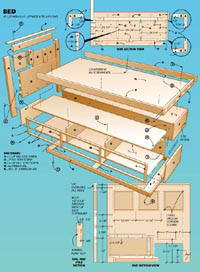| BED AND STORAGE BOXES |
| A platform bed that's more than
just a place to sleep. |
| TEXT AND PHOTOS BY NEAL
BARRETT |
|
 |
 |

Íàæìèòå äëÿ óâåëè÷åíèÿ
|
Beds are for sleeping, right? Well, not if you're a
kid. If you're a kid, bed is the place to read, dream,
plot and scheme—or just while away a rainy afternoon.
It's gossip central after school is out and the
intensive care unit during a bout with the flu. It's the
place to return to when the day is done—and sometimes,
it's just the best place to be alone.
Now that you know it's special, the job is to build a
bed that's up to snuff. Our design takes care of all the
basics, with a little extra just for fun. It's made of
plywood and poplar and we've designed it to go together
without a cabinet shop full of clamps. Underneath,
there's ample storage, with enough space for a pile of
games, books and the family cat. As for good looks,
we've incorporated a strong but simple visual theme that
matches the rest of our bedroom suite. | |
 |
 |
|
 |
 |
|
 |
| 10--Use your
worktable as a registration surface when cutting the
slots in the storage box partition panels. | |
 |
 |
 |
 |
| 12--With all parts
aligned, bore screwholes through the top and secure the
panel. Turn the assembly over and fasten the bottom. | |
 |
 |
 |
 |
 |
|
MATERIALS LIST–BED
|
| Key |
No.</ B> |
Size and description (use) |
| A |
2 |
1 1/2 x 3 1/2 x 38 3/4" poplar (stile) |
| B |
2 |
1 1/2 x 3 1/2 x 9" poplar (mullion) |
| C |
1 |
1 1/2 x 3 1/2 x 34" poplar (rail) |
| D* |
1 |
1 1/2 x 16 3/4 x 34" poplar (rail) |
| E |
3 |
3 1/2 x 10 x 10" plywood (panel) |
| F |
1 |
3/4 x 2 x 41 1/2" poplar (cap) |
| G |
4 |
3/4 x 9 x 18 1/4" plywood (divider) |
| H |
2 |
3/4 x 9 x 74 1/4" plywood (back) |
| I |
4 |
3/4 x 19 x 74 1/4" plywood
(top/bottom) |
| J |
4 |
3/4 x 10 1/2 x 19" plywood (end) |
| K |
4 |
3/4 x 7/8 x 74 1/16" poplar (facing) |
| L |
4 |
3/4 x 7/8 x 10 9/16" poplar (facing) |
| M |
4 |
3/4 x 7/8 x 81 3/16" poplar (facing) |
| N |
2 |
3/4 x 2 3/4 x 73 1/4" plywood (toe
kick face) |
| O |
2 |
3/4 x 2 3/4 x 33" plywood (toe kick
end) |
| P |
3 |
3/4 x 3 1/2 x 33" plywood (cleat) |
| Q |
1 |
3/4 x 39 1/2 x 75 3/4" plywood
(platform) |
| R |
2 |
3/4 x 3 1/2 x 76 1/2" poplar (platform
edge) |
| S |
1 |
3/4 x 3 1/2 x 39 1/2" poplar (platform
end) |
Misc: Misc.: No. 20 joining
plates; 2 1/4" No. 10 fh woodscrews; 2" No. 8 fh
woodscrews; 11/4" No. 8 fh woodscrews; 6d finish nails;
glue; sandpaper; latex primer and enamel.
Note: All
plywood birch veneer
*Laminate from narrower stock
| |
|
| |